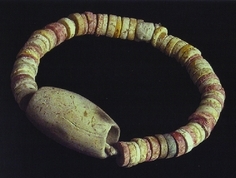
It has taken 50 years for a proper context-based report to appear on Lepenski Vir—that socially complex hunter-fisher-gatherer site on the right bank of the Danube in the Iron Gates gorge. For that, we all owe a huge debt of gratitude to Dušan Borić for collecting the data from the Lepenski Vir archive in Belgrade University and synthesising the mortuary material. This is a beautifully produced, fully bilingual volume, for which the Serbian Archaeological Society can be justly proud. It will be a fundamental reference book for future studies of the Iron Gates Mesolithic and a must-read book for all hunter-gatherer specialists. But why did it take so long to appear?
The first synthesis (in Serbian) of Lepenski Vir by Dragoslav Srejović (Reference Srejović1969) advanced the view that all of the trapezoidal structures with red-plaster floors and all of the sculpted boulders dated to the local Mesolithic (Lepenski Vir phases I & II), pre-dating the appearance of the earliest farmers in the central Balkans. It was only in the third phase (Lepenski Vir III) that farmers settled at the site, and the forager supernova was eclipsed. These views were strongly criticised by John Nandris (Reference Nandris1968). Srejović never fully accepted Nandris’s alternative dating of Lepenski Vir phases I–III to a period coeval with the first farming communities, and there the matter rested, even with the publication of the sculpted boulders (Srejović & Babović Reference Srejović and Babović1983), in which the Srejović chronology was restated. Other researchers pressed Srejović for a full publication of Lepenski Vir, but this never happened; it was assumed that the pressures of rescue work at the site had hindered the quality of the documentation. It was only after the death of Dragoslav Srejović in 1996 that a Belgrade bombshell hit the archaeological community—there was a Lepenski Vir archive, with detailed information about the buildings, the burials and the objects. Ivana Radovanović’s early study of the archive, however, showed that the documentation supported the Nandris chronology rather than the Srejović view; this was presumably the reason for Srejović suppressing his own archive for 30 years.
Thus the second part of the Lepenski Vir story is based on the findings in the archive, which enabled a contextual understanding of the burials and led directly to intensive scientific research over the last two decades to understand the origins and diet of Mesolithic and Neolithic persons buried in the Iron Gates gorge. It is the Lepenski Vir archive that has allowed the production of the book under review—a point that Borić perhaps underplays.
After two introductory chapters, the volume moves to a chronological account of changing mortuary and other practices in four phases: the Early and the Middle Mesolithic (9500–7300 BC), the Mesolithic–Neolithic transition (Lepenski Vir I & II: 6150–5950 BC) and the Early Neolithic (5950–5500 BC). Most striking about what is, in effect, a well-dated Srejović sequence, underpinned by over 100 AMS dates, is the abandonment of this supposedly central place for over a millennium, during the ‘Late Mesolithic’, when most other Iron Gates sites were occupied. Thus, in the time immediately preceding the development of the remarkable trapezoidal buildings and sculpted boulders at Lepenski Vir, we have no evidence from the site itself of what caused these changes, supposedly linked to a re-structuring of the Iron Gates Mesolithic cosmology at 7300 BC towards a more animist concept of relations between humans and fish. Perhaps the biggest gap in the book is that Borić does not account for this development with an interpretation of the evidence from other Late Mesolithic sites.
What Borić achieves comprehensively is the first detailed account of all of the burials at Lepenski Vir, not only in the form of a catalogue but also through discussion of a number of themes—the placing of the body, its orientation, the frequency of disarticulated burials, the associations with animal parts or sculpted boulders, the development of personhood and the associations within or outside trapezoidal buildings. These sections contain many new and interesting interpretations of the well-known aspects of Lepenski Vir and are mostly well argued. I was surprised that the excellent work on disarticulated burials by Rosalind Wallduck (Reference Wallduck2013) was not cited more extensively: Wallduck has demonstrated that disarticulation was often the end-point of a much longer and complex operational chain than the burial of complete bodies.
The general interpretation that Borić offers is that Lepenski Vir changed functions, and its populations had different diets and origins in each of the four main phases of occupation: 1) local persons establishing a fishing camp in the Early Mesolithic but with some mixed aquatic/terrestrial diets; 2) continuing as such in the Middle Mesolithic but with some special burials of local persons with mostly aquatic diets; (?) abandonment for no obvious reason in the Late Mesolithic; 3) a central place for 100–200 years in the Mesolithic to Neolithic transition phase, with an elaborate built environment, some social ranking, intensified contacts with communities outside the gorge and the on-site burial of most residents—a high proportion being locals with a mixture of terrestrial and aquatic diets; and 4) the occupation by early farmers with overwhelmingly terrestrial diets, whose burials featured women from beyond the gorge.
It will take another generation of scientific research to overthrow these main conclusions, which set Lepenski Vir in a much more secure place within the study of global hunter-gatherer archaeology. The idea that the site was a central place exhibiting a fusion of different cultural traditions that were ultimately incompatible sounds like good, old-fashioned Balkan culture-history. But this volume is much more than that—it provides fundamental contextual information and excellent archaeological science to justify that Balkan culture-history. Srejović would have been proud of this volume!


